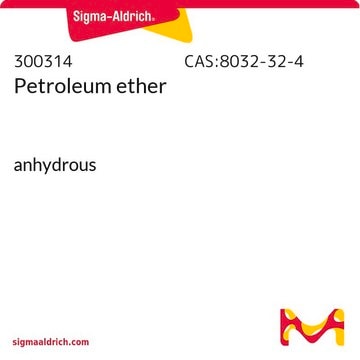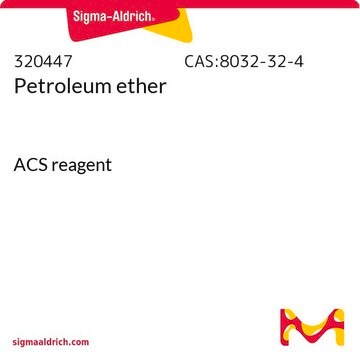673838
Petroleum ether
ACS reagent
About This Item
Prodotti consigliati
Grado
ACS reagent
Densità del vapore
2.5 (vs air)
Tensione di vapore
25.8 psi ( 55 °C)
7.99 psi ( 20 °C)
Stato
liquid
Temp. autoaccensione
475 °F
Limite di esplosione
8 %
dilution
(for analytical testing)
Impurezze
acidity, passes test
Residuo dopo evaporazione
≤0.001%
Colore
APHA: ≤10
Indice di rifrazione
n20/D 1.363 (lit.)
P. ebollizione
30-60 °C (lit.)
35-60 °C
Densità
0.64 g/mL at 25 °C (lit.)
Stringa SMILE
[Mg+]c1ccc(cc1)C.[Br-]
InChI
1S/C7H7.BrH.Mg/c1-7-5-3-2-4-6-7;;/h3-6H,1H3;1H;/q;;+1/p-1
ZRJNGFJIBZKXTP-UHFFFAOYSA-M
Cerchi prodotti simili? Visita Guida al confronto tra prodotti
Descrizione generale
Avvertenze
Danger
Indicazioni di pericolo
Consigli di prudenza
Classi di pericolo
Aquatic Chronic 2 - Asp. Tox. 1 - Flam. Liq. 1 - Skin Irrit. 2 - STOT SE 3
Organi bersaglio
Central nervous system
Codice della classe di stoccaggio
3 - Flammable liquids
Classe di pericolosità dell'acqua (WGK)
WGK 2
Punto d’infiammabilità (°F)
-56.2 °F
Punto d’infiammabilità (°C)
-49 °C
Scegli una delle versioni più recenti:
Possiedi già questo prodotto?
I documenti relativi ai prodotti acquistati recentemente sono disponibili nell’Archivio dei documenti.
I clienti hanno visto anche
Active Filters
Il team dei nostri ricercatori vanta grande esperienza in tutte le aree della ricerca quali Life Science, scienza dei materiali, sintesi chimica, cromatografia, discipline analitiche, ecc..
Contatta l'Assistenza Tecnica.
















